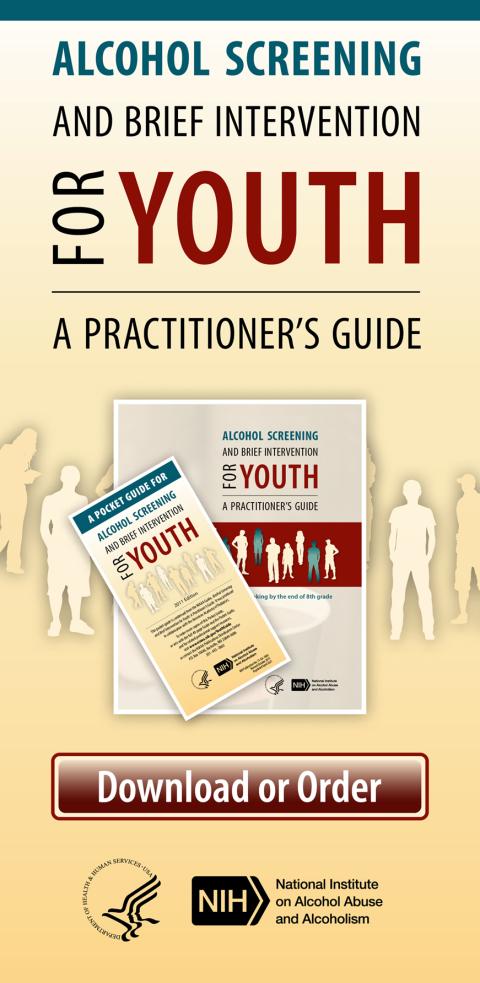Alcohol Screening and Brief Intervention for Youth: A Practitioner's Guide
For Health Care Professionals
-

- The quick two-question screening tool and risk level estimates in Alcohol Screening and Brief Intervention for Youth will give you a good idea as to your patients’ level of risk for alcohol-related problems. If you wish to follow up with other tools, two to consider are the 10-question AUDIT and the 6-question CRAFFT. Both the AUDIT and the CRAFFT can be used as a paper–pencil or electronic screen, and the CRAFFT can be verbally administered.
- The Alcohol Use Disorders Identification Test (AUDIT) (PDF) focuses on drinking patterns and alcohol-related behaviors. Research supports use of the AUDIT for adolescents ages 14 to 18, with cut points of 2 for identifying any alcohol problem use and 3 for alcohol abuse or dependence (Knight et al., 2003).
- The CRAFFT asks about problem behaviors related to the use of alcohol or other drugs. Research indicates that a “yes” to two questions signals a problem needing further evaluation and that a score of four or more “should raise suspicion of substance dependence” (Knight et al., 2002).
- Training
- Alcohol Screening and Brief Intervention for Youth: A Practitioner's Guide training course (CME credit no longer available)
- Adolescent Substance Use and Prescription Medication Misuse course (CME credit no longer available)
- EQIPP: Substance Use–Screening, Brief Intervention, Referral to Treatment
- Key resources from the American Academy of Pediatrics (AAP) National Committee on Substance Use and Prevention
- Rethinking Drinking website from NIAAA – Provides background information about alcohol, including drink size calculators and symptoms of alcohol use disorder
- Clinician’s toolkit for implementing mental health screenings (available for purchase from AAP): Addressing Mental Health Concerns in Primary Care: A Clinician’s Toolkit
- The quick two-question screening tool and risk level estimates in Alcohol Screening and Brief Intervention for Youth will give you a good idea as to your patients’ level of risk for alcohol-related problems. If you wish to follow up with other tools, two to consider are the 10-question AUDIT and the 6-question CRAFFT. Both the AUDIT and the CRAFFT can be used as a paper–pencil or electronic screen, and the CRAFFT can be verbally administered.
- Confidential health care for youth
- Center for Adolescent Health and the Law – Offers monographs on minor consent laws and professional association policies
- Society for Adolescent Health and Medicine – Offers a sample confidentiality statement, billing guidance, and other resources
- Motivational interviewing – Background and training information
- Substance Abuse Facility Locator – Includes adolescent treatment programs (Substance Abuse and Mental Health Services Administration, SAMHSA)
For Parents
- Publications
- Websites
- Talk. They Hear You. (SAMHSA)
- The AAP Parenting Website: www.healthychildren.org; in particular, “Alcohol: The Most Popular Choice” (AAP)
- Partnership to End Addiction
- College Drinking Prevention site, page for College Parents (NIAAA)
- Driving and Safety Agreements
- Parent-Teen Driving Agreement (AAP)
- “Contract for Life” (Students Against Destructive Decisions)
Support for Patients Whose Parents Have Drinking Problems
- Al-Anon Family Groups, including Alateen
- National Association for Children of Addiction “Just 4 Kids” page

